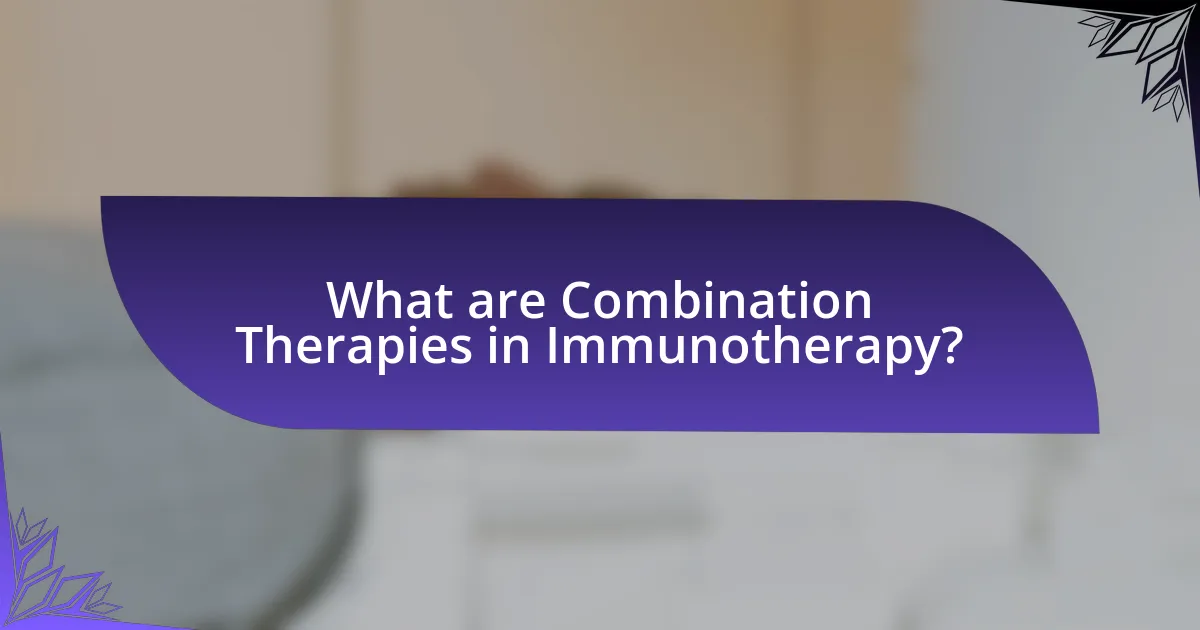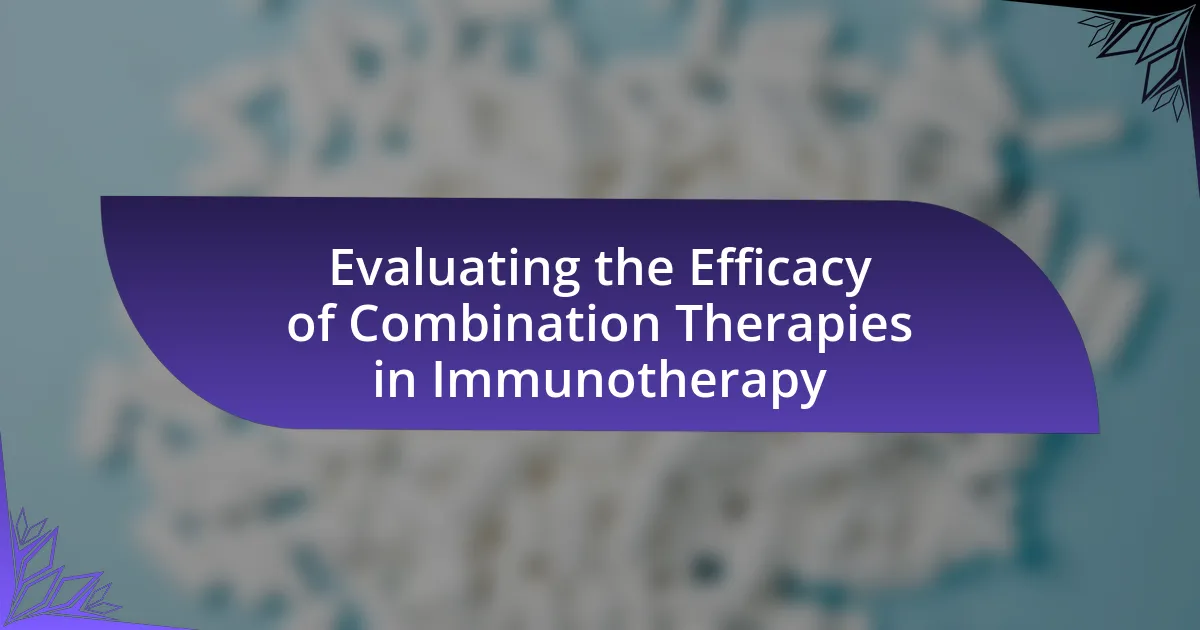Combination therapies in immunotherapy involve the simultaneous use of multiple therapeutic agents to enhance the immune system’s ability to combat cancer. This article evaluates the efficacy of these therapies, highlighting their advantages over monotherapies, including improved response rates and prolonged survival. Key components such as synergistic drug interactions, targeted mechanisms, and optimized dosing regimens are discussed, along with the challenges faced in evaluating their effectiveness. The article also explores current research on various combinations, the role of personalized medicine, and best practices for implementation in clinical settings, providing a comprehensive overview of the future directions in combination therapies for cancer treatment.

What are Combination Therapies in Immunotherapy?
Combination therapies in immunotherapy refer to the simultaneous use of two or more therapeutic agents to enhance the immune system’s ability to fight cancer. This approach aims to improve treatment efficacy by targeting multiple pathways involved in tumor growth and immune evasion. For instance, combining immune checkpoint inhibitors with targeted therapies or chemotherapy has shown improved outcomes in various cancers, as evidenced by clinical trials demonstrating increased response rates and prolonged survival in patients.
How do combination therapies differ from monotherapies in immunotherapy?
Combination therapies in immunotherapy involve the use of two or more therapeutic agents to enhance the immune response against cancer, while monotherapies utilize a single agent. Combination therapies can target multiple pathways or mechanisms, potentially leading to improved efficacy and reduced resistance, as evidenced by studies showing that combining immune checkpoint inhibitors with other treatments can result in higher response rates compared to monotherapy alone. For instance, the combination of nivolumab and ipilimumab has demonstrated superior outcomes in melanoma patients compared to either drug used individually, highlighting the potential benefits of combination approaches in overcoming tumor heterogeneity and immune evasion.
What are the key components of combination therapies?
The key components of combination therapies include synergistic drug interactions, targeted mechanisms of action, and optimized dosing regimens. Synergistic drug interactions enhance therapeutic efficacy by using multiple agents that work together to improve treatment outcomes, as evidenced by studies showing increased response rates in cancer therapies when combining immunotherapies with chemotherapy or targeted therapies. Targeted mechanisms of action ensure that each component of the therapy addresses different pathways or aspects of the disease, which can lead to more comprehensive treatment effects. Optimized dosing regimens are crucial for maximizing the benefits of each agent while minimizing potential side effects, as demonstrated in clinical trials where carefully timed administration of drugs resulted in improved patient tolerability and outcomes.
Why are combination therapies considered for immunotherapy?
Combination therapies are considered for immunotherapy because they can enhance the overall effectiveness of treatment by targeting multiple pathways involved in tumor growth and immune evasion. This approach allows for a synergistic effect, where the combined action of different agents can lead to improved patient outcomes compared to monotherapy. For instance, studies have shown that combining immune checkpoint inhibitors with other therapeutic modalities, such as chemotherapy or targeted therapies, can lead to higher response rates and prolonged survival in various cancers, as evidenced by clinical trials demonstrating significant improvements in progression-free survival and overall survival rates.
What types of combination therapies are currently being evaluated?
Currently, various types of combination therapies are being evaluated in immunotherapy, including immune checkpoint inhibitors combined with targeted therapies, chemotherapy, and radiation therapy. For instance, studies are investigating the efficacy of combining anti-PD-1 or anti-CTLA-4 antibodies with small molecule inhibitors like BRAF or MEK inhibitors in melanoma treatment. Additionally, the combination of immune checkpoint inhibitors with traditional chemotherapy has shown promise in enhancing anti-tumor responses in non-small cell lung cancer. Research also explores the synergistic effects of combining immunotherapy with radiation, aiming to improve local and systemic tumor control. These evaluations are supported by clinical trials that assess the safety and efficacy of these combinations, demonstrating potential improvements in patient outcomes.
What are the most common drug combinations used in immunotherapy?
The most common drug combinations used in immunotherapy include pembrolizumab with chemotherapy, nivolumab with ipilimumab, and atezolizumab with chemotherapy. Pembrolizumab, a PD-1 inhibitor, is frequently combined with chemotherapy to enhance anti-tumor responses in non-small cell lung cancer, as demonstrated in clinical trials showing improved survival rates. Nivolumab and ipilimumab, both immune checkpoint inhibitors, are used together in melanoma treatment, with studies indicating a significant increase in overall survival compared to monotherapy. Atezolizumab, an anti-PD-L1 antibody, is often paired with chemotherapy in various cancers, including triple-negative breast cancer, where it has shown efficacy in improving patient outcomes.
How do these combinations target different aspects of the immune response?
Combination therapies in immunotherapy target different aspects of the immune response by simultaneously activating multiple immune pathways. For instance, combining checkpoint inhibitors with cytokine therapies enhances T-cell activation and proliferation while also promoting the recruitment of immune cells to the tumor microenvironment. This dual approach not only increases the overall immune response but also addresses potential resistance mechanisms that tumors may employ. Research has shown that such combinations can lead to improved clinical outcomes, as evidenced by studies demonstrating enhanced tumor regression and prolonged survival in patients with various cancers when treated with these multi-faceted strategies.
What are the potential benefits of using combination therapies in immunotherapy?
Combination therapies in immunotherapy can enhance treatment efficacy by targeting multiple pathways involved in tumor growth and immune evasion. This approach can lead to improved patient outcomes, such as increased response rates and prolonged survival. For instance, studies have shown that combining immune checkpoint inhibitors with other modalities, like chemotherapy or targeted therapies, can result in synergistic effects, thereby overcoming resistance mechanisms that single-agent therapies may encounter. Additionally, combination therapies can help to broaden the immune response, allowing for a more robust attack on cancer cells, which has been evidenced in clinical trials demonstrating higher overall response rates compared to monotherapies.
How do combination therapies enhance treatment efficacy?
Combination therapies enhance treatment efficacy by targeting multiple pathways involved in disease progression, thereby increasing the likelihood of therapeutic success. This approach allows for synergistic effects, where the combined action of different agents results in a greater effect than the sum of their individual effects. For instance, in cancer treatment, combining immune checkpoint inhibitors with chemotherapy has been shown to improve overall survival rates compared to monotherapy, as evidenced by studies such as the KEYNOTE-189 trial, which demonstrated significant improvements in progression-free survival in non-small cell lung cancer patients receiving combination therapy.
What role do combination therapies play in overcoming resistance?
Combination therapies play a crucial role in overcoming resistance by targeting multiple pathways simultaneously, which reduces the likelihood of tumor cells developing resistance mechanisms. This approach enhances treatment efficacy, as evidenced by studies showing that combining immune checkpoint inhibitors with other modalities, such as chemotherapy or targeted therapies, can lead to improved patient outcomes. For instance, research published in the Journal of Clinical Oncology demonstrated that patients receiving combination immunotherapy had a higher response rate compared to those on monotherapy, indicating that such strategies can effectively counteract resistance in cancer treatment.

How is the efficacy of combination therapies evaluated?
The efficacy of combination therapies is evaluated through clinical trials that assess the therapeutic outcomes compared to standard treatments or monotherapies. These trials typically measure endpoints such as overall survival, progression-free survival, and response rates, utilizing statistical analyses to determine the significance of the results. For instance, a study published in the Journal of Clinical Oncology demonstrated that combination therapies in immunotherapy led to improved survival rates in patients with advanced melanoma, highlighting the effectiveness of this approach.
What methodologies are used to assess the efficacy of combination therapies?
Methodologies used to assess the efficacy of combination therapies include randomized controlled trials (RCTs), meta-analyses, and biomarker analysis. RCTs are considered the gold standard for evaluating treatment effects, as they minimize bias and allow for direct comparisons between combination therapies and standard treatments. Meta-analyses synthesize data from multiple studies to provide a comprehensive overview of efficacy across different populations and settings. Biomarker analysis helps identify patient subgroups that may benefit most from specific combination therapies, enhancing personalized treatment approaches. These methodologies collectively ensure robust evaluation of combination therapies in immunotherapy contexts.
How do clinical trials measure the success of combination therapies?
Clinical trials measure the success of combination therapies primarily through endpoints such as overall survival, progression-free survival, and response rates. These metrics provide quantifiable data on how well the combination therapy performs compared to standard treatments or monotherapies. For instance, a clinical trial may report that a combination therapy improves overall survival by 20% compared to a control group, indicating its effectiveness. Additionally, adverse events and quality of life assessments are monitored to evaluate the safety and tolerability of the combination therapies, ensuring a comprehensive understanding of their impact on patients.
What are the key performance indicators for evaluating efficacy?
Key performance indicators for evaluating efficacy in combination therapies in immunotherapy include overall response rate (ORR), progression-free survival (PFS), overall survival (OS), and duration of response (DoR). ORR measures the percentage of patients whose tumors shrink or disappear after treatment, providing insight into the immediate effectiveness of the therapy. PFS indicates the length of time patients live without disease progression, reflecting the treatment’s ability to control cancer growth. OS assesses the length of time patients survive after treatment, serving as a critical measure of long-term efficacy. DoR evaluates how long the treatment effects last, offering additional context on the sustainability of the response. These indicators are essential for determining the success of combination therapies in improving patient outcomes in immunotherapy.
What challenges are faced in evaluating the efficacy of combination therapies?
Evaluating the efficacy of combination therapies presents several challenges, including the complexity of interactions between drugs, variability in patient responses, and difficulties in designing appropriate clinical trials. The interactions between multiple agents can lead to synergistic, additive, or antagonistic effects, complicating the assessment of individual contributions to treatment outcomes. Variability in patient responses arises from genetic differences, underlying health conditions, and prior treatments, making it hard to generalize findings. Additionally, clinical trial design must account for these factors, often requiring larger sample sizes and longer follow-up periods to detect meaningful differences in efficacy, as evidenced by the need for adaptive trial designs in recent studies.
How do patient variability and tumor heterogeneity impact evaluation?
Patient variability and tumor heterogeneity significantly impact evaluation by influencing treatment responses and outcomes in immunotherapy. Individual differences in genetics, immune system function, and overall health can lead to varied responses to therapies, complicating the assessment of efficacy. Additionally, tumor heterogeneity, characterized by diverse cell populations within a single tumor, can result in differential sensitivity to treatment, making it challenging to evaluate the overall effectiveness of combination therapies. Studies have shown that tumors with high heterogeneity often exhibit resistance to therapies, which can skew evaluation results and lead to misleading conclusions about treatment efficacy.
What are the limitations of current evaluation methods?
Current evaluation methods for combination therapies in immunotherapy face several limitations, including a lack of standardized metrics, variability in patient responses, and challenges in measuring long-term outcomes. The absence of universally accepted evaluation criteria can lead to inconsistent results across studies, making it difficult to compare efficacy. Additionally, individual patient variability, influenced by genetic, environmental, and tumor-specific factors, complicates the assessment of treatment effectiveness. Furthermore, many evaluation methods focus on short-term responses, neglecting the importance of long-term survival and quality of life metrics, which are crucial for understanding the full impact of combination therapies.

What are the future directions for combination therapies in immunotherapy?
Future directions for combination therapies in immunotherapy include the integration of novel agents, such as targeted therapies and oncolytic viruses, alongside existing immune checkpoint inhibitors to enhance therapeutic efficacy. Research indicates that combining immune checkpoint inhibitors with targeted therapies can lead to improved response rates in various cancers, as demonstrated in studies like the KEYNOTE-189 trial, which showed significant survival benefits when pembrolizumab was combined with chemotherapy in non-small cell lung cancer. Additionally, the exploration of biomarker-driven approaches to tailor combination therapies is gaining traction, allowing for more personalized treatment strategies that could optimize patient outcomes.
How can emerging technologies improve the evaluation of combination therapies?
Emerging technologies can enhance the evaluation of combination therapies by enabling more precise and efficient data collection and analysis. For instance, advanced genomic sequencing technologies allow for the identification of specific biomarkers that predict patient responses to combination therapies, thereby facilitating personalized treatment plans. Additionally, artificial intelligence and machine learning algorithms can analyze vast datasets from clinical trials to identify patterns and optimize treatment combinations, improving efficacy and reducing adverse effects. A study published in Nature Reviews Drug Discovery highlights that integrating these technologies can lead to more informed decision-making in clinical settings, ultimately enhancing patient outcomes in immunotherapy.
What role does personalized medicine play in future combination therapies?
Personalized medicine plays a crucial role in future combination therapies by tailoring treatment strategies to individual patient profiles, which enhances therapeutic efficacy and minimizes adverse effects. This approach utilizes genetic, biomarker, and phenotypic information to identify the most effective drug combinations for specific patient populations. For instance, studies have shown that patients with certain genetic mutations respond better to specific immunotherapy agents, allowing for optimized combinations that improve overall treatment outcomes. By integrating personalized medicine into combination therapies, healthcare providers can achieve more precise targeting of cancer cells while preserving healthy tissue, ultimately leading to improved survival rates and quality of life for patients undergoing immunotherapy.
How might novel biomarkers enhance efficacy evaluation?
Novel biomarkers can enhance efficacy evaluation by providing precise, quantifiable measures of treatment response and patient stratification. These biomarkers, such as specific proteins or genetic signatures, enable clinicians to identify which patients are likely to benefit from combination therapies in immunotherapy, thereby optimizing treatment plans. For instance, studies have shown that the presence of certain immune checkpoint molecules can predict responses to therapies targeting those pathways, leading to more tailored and effective treatment strategies. This targeted approach not only improves patient outcomes but also reduces unnecessary exposure to ineffective treatments, as evidenced by research indicating that patients with specific biomarker profiles experience significantly higher response rates to immunotherapy combinations.
What best practices should be followed when implementing combination therapies in clinical settings?
Best practices for implementing combination therapies in clinical settings include thorough patient selection, careful monitoring of drug interactions, and establishing clear treatment protocols. Patient selection should be based on individual biomarkers and disease characteristics to ensure optimal efficacy. Monitoring drug interactions is crucial to minimize adverse effects and enhance therapeutic outcomes, as evidenced by studies showing that specific combinations can lead to increased toxicity if not managed properly. Establishing clear treatment protocols helps standardize care and allows for better assessment of outcomes, which is supported by clinical guidelines that recommend structured approaches to combination therapies in immunotherapy.
How can clinicians optimize treatment plans for patients using combination therapies?
Clinicians can optimize treatment plans for patients using combination therapies by tailoring the selection of agents based on individual patient characteristics and disease profiles. This approach involves assessing biomarkers, genetic mutations, and previous treatment responses to identify the most effective drug combinations. For instance, studies have shown that specific combinations, such as immune checkpoint inhibitors with targeted therapies, can enhance therapeutic efficacy and improve patient outcomes. Research published in the Journal of Clinical Oncology indicates that personalized combination therapies can lead to higher response rates and prolonged survival in cancer patients, demonstrating the importance of individualized treatment strategies in optimizing patient care.
What are the common pitfalls to avoid in combination therapy administration?
Common pitfalls to avoid in combination therapy administration include inadequate patient selection, improper dosing, and lack of monitoring for drug interactions. Inadequate patient selection can lead to ineffective treatment outcomes, as not all patients respond similarly to combination therapies. Improper dosing may result in subtherapeutic effects or increased toxicity, which can compromise patient safety and treatment efficacy. Additionally, failing to monitor for drug interactions can lead to adverse effects or reduced therapeutic benefits, as certain drugs may counteract each other or exacerbate side effects. These pitfalls highlight the importance of careful planning and ongoing assessment in combination therapy to ensure optimal patient outcomes.



